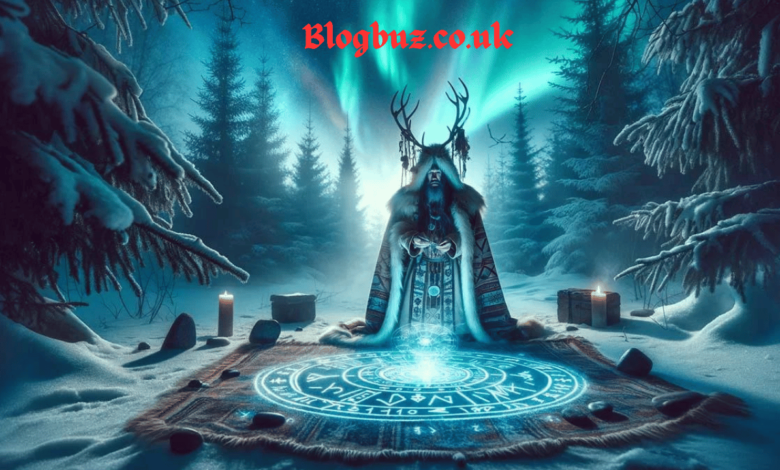The Enigmatic Känätääj: Guardian and Trickster of Northern European Folklore

In the rich tapestry of Northern European folklore, the figure of Känätääj stands out as a multifaceted entity, both revered and feared. This mythical creature, predominantly found in Finnish and Estonian traditions, embodies the duality of nature itself. As a guardian of the forests and a mischievous trickster, Känätääj’s stories have been passed down through generations, captivating audiences with its mysterious allure.
Origins and Etymology
The term “Känätääj” has intriguing etymological roots. Linguistic scholars trace its origins to ancient Finnish and Estonian languages, with interpretations suggesting connections to words meaning “to whisper” or “to lurk”. This etymology hints at the creature’s elusive nature and its propensity for stealth, characteristics that are central to its mythos.
Mythological Significance
Känätääj holds a special place in Northern European mythology as both a guardian and a trickster. In many stories, Känätääj protects the forests and wildlife, ensuring nature’s balance. Those who respect the land often receive its protection. However, those who disrespect nature may find themselves lost or tricked by Känätääj.
The dual nature of Känätääj makes it unique. As a guardian, it is honoured in rituals and ceremonies. Shamans and wise elders often seek its guidance, believing Känätääj can connect them with the spirit world. This role highlights Känätääj’s importance in maintaining harmony between humans and nature .
On the other hand, Känätääj’s trickster side adds excitement and caution to the tales. It can lead travellers astray, play pranks, and create confusion. This aspect teaches lessons about respecting nature and being wary of the unknown. The trickster side of it reminds us that nature is powerful and unpredictable.
Characteristics and Traits
Describing the physical appearance of Känätääj is challenging, as accounts vary widely. Some narratives describe it as ethereal and ephemeral, while others depict it as grotesque and monstrous. Many stories highlight Känätääj’s shape-shifting ability, allowing it to blend seamlessly into its surroundings and confound those who seek to perceive it.
Känätääj is often associated with mischief and trickery. It takes pleasure in pulling practical jokes on unsuspecting people or leading them astray in the forest’s depths. Despite its elusive nature, Känätääj is said to possess keen intelligence, often outwitting those who dare to challenge its domain.
Perhaps most intriguingly, Känätääj is often linked to the realm of dreams and the subconscious mind. In Finnish and Estonian folklore, it is believed to possess the ability to enter the dreams of mortals, whispering cryptic messages or imparting mystical knowledge to those deemed worthy. This connection to the world of dreams adds another layer of complexity to its enigmatic nature, blurring the lines between reality and imagination.
Mystical Powers and Abilities
Känätääj’s mystical powers are a significant part of its legend. Shape-shifting is one of its most notable abilities, allowing it to transform into different forms and blend into its surroundings seamlessly. Witnesses have reported experiencing reality distortion and time manipulation in Känätääj’s presence, with objects appearing and disappearing mysteriously, challenging our understanding of reality.
Another intriguing power is telepathic communication. Känätääj is said to convey messages through dreams or direct psychic transmissions. These messages often contain mystical knowledge or warnings, contributing to its enigmatic aura.
These mystical abilities make Känätääj a powerful symbol in folklore and spiritual practices. They reflect humanity’s fascination with the unknown and the supernatural. They remind us of the still-existing mysteries and urge us to explore and understand them.
Cultural Significance
Within the cultural context of the regions where it is revered, Känätääj holds multifaceted significance. It symbolizes the untamed wilderness, the mysteries of the unknown, and the intricate relationship between humanity and the natural world. As a guardian of the forest, it embodies the primal forces that govern the wilderness, commanding respect and reverence from those who dwell in its proximity.
Moreover, Känätääj serves as a cautionary tale, warning against the dangers of venturing too deep into the unknown or succumbing to the allure of forbidden knowledge. Its ambiguous nature reflects the complexities of human existence, reminding us of the inherent duality of light and darkness that resides within us all.
Contemporary Relevance
In contemporary times, the legend of Känätääj continues to captivate the imagination of storytellers, artists, and enthusiasts of folklore and mythology. It is seen in various media, including literature and film, to visual art and music, perpetuating its legacy and ensuring its enigmatic allure endures for generations to come.
Modern interpretations often highlight environmental themes, reflecting current ecological preservation and sustainability concerns. Känätääj’s role as a guardian of nature has taken on new significance in the context of modern environmentalism, serving as a powerful symbol of the need to preserve and protect natural ecosystems.
Artists have long been fascinated by Känätääj, creating visual representations that capture its mystical essence. Although digital art has replaced conventional paintings, sculptures, and installations, Känätääj continues to inspire creative expression, exploring its duality.
In indigenous communities, Känätääj remains a symbol of connection to the natural world. It embodies the values of respect and harmony with the environment, prompting discussions about humanity’s relationship with nature and the impact of modernization.
Conclusion
The legend of Känätääj stands as a testament to the enduring power of folklore and mythology to capture the human imagination and impart timeless wisdom. As we work to solve the puzzles surrounding this mysterious creature, we gain insights into the intricate web of cultural customs that have influenced our collective consciousness.
In its elusive presence, we find echoes of our deepest fears and desires, our fascination with the unknown, and our eternal quest for meaning in a world fraught with ambiguity. Whether viewed as a guardian of the forest, a trickster spirit, or a harbinger of dreams, Känätääj remains a symbol of the enduring bond between humanity and the mysteries that lie beyond the realms of comprehension.
By delving into the myth of Känätääj, we are reminded of the delicate equilibrium that exists between the environment and humankind. It urges us to respect and cherish the earth and all its inhabitants. As we navigate an increasingly complex world, the lessons of Känätääj resonate, reminding us of the interconnectedness of all living beings and the importance of living in harmony with nature.
Read More: Exploring the Enigmatic Masqlaseen: Guardians of Ancient Traditions





Web có bố cục rõ ràng, dễ theo dõi.
Hi there! This post could not be written any better! Reading through this post reminds me of my previous room mate! He always kept chatting about this. I will forward this post to him. Pretty sure he will have a good read. Many thanks for sharing!|
This is a topic that is close to my heart… Many thanks! Exactly where are your contact details though?|
Các danh mục trên web được bố trí hợp lý, dễ nhìn.
For most recent news you have to pay a visit web and on internet I found this site as a most excellent site for most recent updates.|
Hi88 – là thương hiệu giải trí trực tuyến hàng đầu, quy tụ những sản phẩm hấp dẫn nhất như thể thao, casino live, bắn cá và slot nổ hũ. Đăng ký ngay tại Hi88.soccer để nhận quà tặng 58K miễn phí – ưu đãi độc quyền dành cho tân thủ.
Can you tell us more about this? I’d love to find out more details.|
Web giúp thao tác nhanh chóng và mượt mà.
Giao diện web bắt mắt, hiện đại và dễ thao tác.
If some one wishes to be updated with latest technologies therefore he must be pay a quick visit this website and be up to date everyday.|
My brother suggested I may like this blog. He used to be totally right. This publish actually made my day. You can not consider just how so much time I had spent for this info! Thank you!|
Stunning quest there. What occurred after? Good luck!|
Trải nghiệm chơi game trên web rất mượt mà và ổn định.
nohu90
Trải nghiệm SC88 hôm nay – nơi mọi ván cược đều biến thành cơ hội thắng lớn, cảm giác giải trí đỉnh cao cùng ưu đãi không thể bỏ qua! SC88
I think this is one of the most vital information for me. And i am glad reading your article. But should remark on some general things, The web site style is great, the articles is really great : D. Good job, cheers|
Trải nghiệm SC88 hôm nay – nơi mọi ván cược đều biến thành cơ hội thắng lớn, cảm giác giải trí đỉnh cao cùng ưu đãi không thể bỏ qua! SC88
QQ88 là nền tảng cá cược trực tuyến hàng đầu Việt Nam, mang đến trải nghiệm chơi game hiện đại và giao diện phiên bản mới truy cập dễ dàng trên cả mobile & PC. Hệ thống bảo mật cao cấp, tốc độ load nhanh, tỷ lệ thắng hấp dẫn giúp QQ88bet trở thành nhà cái được hàng triệu khách hàng tin chọn.
QQ88 là nền tảng cá cược trực tuyến hàng đầu Việt Nam, mang đến trải nghiệm chơi game hiện đại và giao diện phiên bản mới truy cập dễ dàng trên cả mobile & PC. Hệ thống bảo mật cao cấp, tốc độ load nhanh, tỷ lệ thắng hấp dẫn giúp QQ88bet trở thành nhà cái được hàng triệu khách hàng tin chọn.
QQ88 là nền tảng cá cược trực tuyến hợp pháp hàng đầu tại châu Á, nơi hàng triệu người chơi lựa chọn để thử vận may với các trò chơi hấp dẫn như casino trực tuyến, thể thao ảo, bắn cá đổi thưởng, và đá gà ăn tiền. Người dùng sẽ được trải nghiệm không gian giải trí sống động với hệ sinh thái trò chơi đa dạng, tỷ lệ trả thưởng cao, ưu đãi siêu khủng, và chính sách hoàn tiền vượt trội. Đặc biệt, QQ88 được cấp phép hợp pháp bởi Isle of Man, và chịu giám sát chất lượng từ Cagayan & Freeport, đảm bảo một môi trường cá cược an toàn – minh bạch – chuẩn quốc tế.
Khám phá ngay SC88 – Sân chơi cá cược đỉnh cao với ưu đãi hấp dẫn và trải nghiệm giải trí mượt mà, an toàn cho mọi bet thủ. SC88
QQ88 là nền tảng cá cược trực tuyến hợp pháp hàng đầu tại châu Á, nơi hàng triệu người chơi lựa chọn để thử vận may với các trò chơi hấp dẫn như casino trực tuyến, thể thao ảo, bắn cá đổi thưởng, và đá gà ăn tiền. Người dùng sẽ được trải nghiệm không gian giải trí sống động với hệ sinh thái trò chơi đa dạng, tỷ lệ trả thưởng cao, ưu đãi siêu khủng, và chính sách hoàn tiền vượt trội. Đặc biệt, QQ88 được cấp phép hợp pháp bởi Isle of Man, và chịu giám sát chất lượng từ Cagayan & Freeport, đảm bảo một môi trường cá cược an toàn – minh bạch – chuẩn quốc tế.
Khám phá ngay SC88 – Sân chơi cá cược đỉnh cao với ưu đãi hấp dẫn và trải nghiệm giải trí mượt mà, an toàn cho mọi bet thủ. SC88